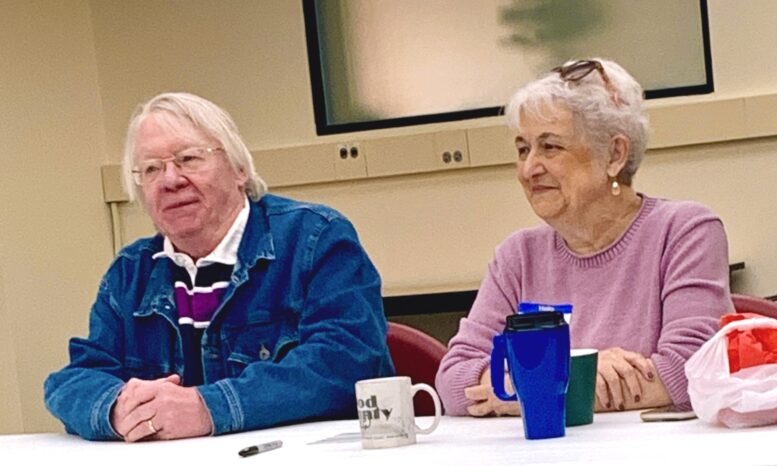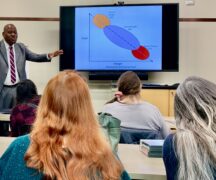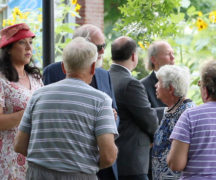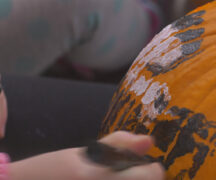By JULIE CARLE
BG Independent News
A Bowling Green postcard collection, vintage radio, 1901 Thanksgiving menu from the Millikin Hotel and a mug from Bowling Green’s early dial-up internet provider brought local history to life during a recent show-and-tell at the Wood County District Public Library.
About a half dozen people showed off prized possessions at the library event—reminiscent of an elementary school show-and-tell. All the presenters were well past elementary age, but they brought the same level of enthusiasm as if they were sharing their pet rock or favorite picture book.
Edna Clemans eagerly opened a binder filled with some of her prized postcards that started a conversation reflecting on the past mode of communication.
“People used to send cards for almost no reason at all,” she said, similar to today when people call family and friends just to say hello. Penny postcards were an affordable and easy way to stay in touch in the late 1800s into the 1920s and beyond.
“When you went on trips, you would send ‘wish you were here’ postcards from wherever you went,” said Jo Sipes, who attended to hear the local history stories that accompanied the found items.
Clemans explained that her four boxes and countless numbers of postcards were acquired over several decades from postcard shows and flea markets. In addition to a robust collection of Bowling Green and Bowling Green State University postcards, she looks for interesting cards of varying themes and from many locations.
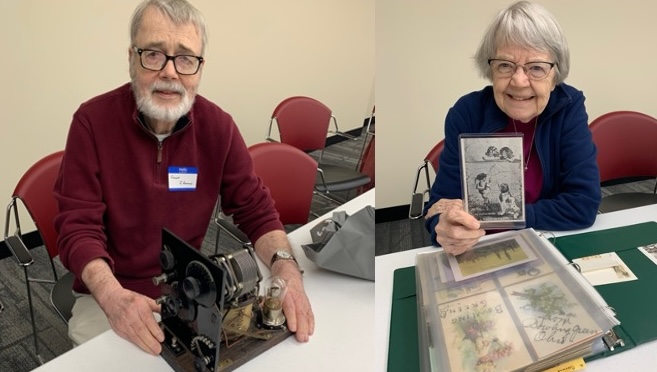
She shared her most interesting postcard from the binder—a 1910 promotion for the Wood County Homecoming. The postcard includes a black and white drawing on the front and arrival directions depending on whether guests were traveling via “Ohio Electric or C.H. & D.” (Cincinnati, Hamilton & Dayton Railway)” or the “T.B.G. & S.” (Toledo, Bowling Green & Southern Traction).
“I found this card, and I really loved it,” she said about the homecoming postcard, but she also had “welcome to” postcards for Grand Rapids, North Baltimore, Risingsun, Rudolph and Weston.
“I’m always amazed at how many cool postcards are out there for the area. That was just the nature of that form of communication,” said Marnie Pratt, the library’s local historian who organized the event.
She frequently looks for local postcards to add to the library’s collection, most of which are scanned and part of the Ohio Memories website. “I love when we find ones we haven’t seen before,” Pratt said.
Sometimes postcards provide a snapshot in time, she added. Postcards of the original home that is now the library’s Carter House showed a porch on the side of the house that had been enclosed at some point in the past.
“When the house was remodeled, the library opened the porch back up to make it look more like it did,” Pratt said.
Attendee Rose Drain said the previous owners of their Court Street home had a postcard of the house that was taken from the Wood County courthouse. “It showed our house with a rail around the tower, which is no longer there, and there are trees along the street. It’s really cool,” she said.
Sue Clanton and Gregg Simpson of Weston brought several mugs with ties to local history. “When I first signed up for this, I thought, ‘We don’t have anything. We are not from Wood County originally,” Clanton said. However, in preparation for the event, she remembered they had a collection of mugs from businesses and organizations.
They shared mugs from WCNet and Bowling Green Community Development Foundation, two organizations that are not as dated as a 1910 postcard, but whose existence has left a mark in Wood County history.
“We both volunteered for WCNet, which didn’t just happen overnight,” Clanton said. The community dial-up internet provider, under the guidance of Scott McEwen and many other people and organizations in the county, was started in 1995. The service relied almost exclusively on volunteers for help desk activities, system support and web development.
When sitting at the help desk after Ohio required area codes to place phone calls, Simpson said the voicemail system was inundated with messages from WCNet users who couldn’t connect. They didn’t realize they had to reconfigure the dial-up adding the area code.
They worked over three hours clearing up the backlogged voicemails and informing WCNet users about the change.
“It’s so funny to think about how quickly internet technology changes,” Pratt said. “Not only how it changed our daily lives so quickly, but also how the technology itself changed so quickly over the years.”
The WCNet story was a great example of the importance of documenting current events. “As a local history librarian, we talk a lot about the 1800s and early 1900s, but what is happening now is going to be somebody else’s history in 50 years,” Pratt said. “The story of how the internet came to Wood County is important to document.”
George Clemans brought out an antique AM radio that he described as a one-person radio that required headphones and a long antenna. “Radios didn’t exist until 1921; then, it became a craze that everyone had to have,” he said.
Though he has a basement full of vintage radios and accessories, the prized radio he shared during the event came out of a barn near Bloomdale. When asked if that was where the radio had been used, he quipped, “It depends on how tolerant the farmer’s wife was.”
Wood County’s location was fortunate for radio owners at the time, George Clemans said. Among the first radio stations to broadcast were KDKA in Pittsburgh and WWJ in Detroit.
“We were right between the two of them and could listen to both of them,” he said. “What radio did was bring the whole world into Bloomdale. It was a radical change.”
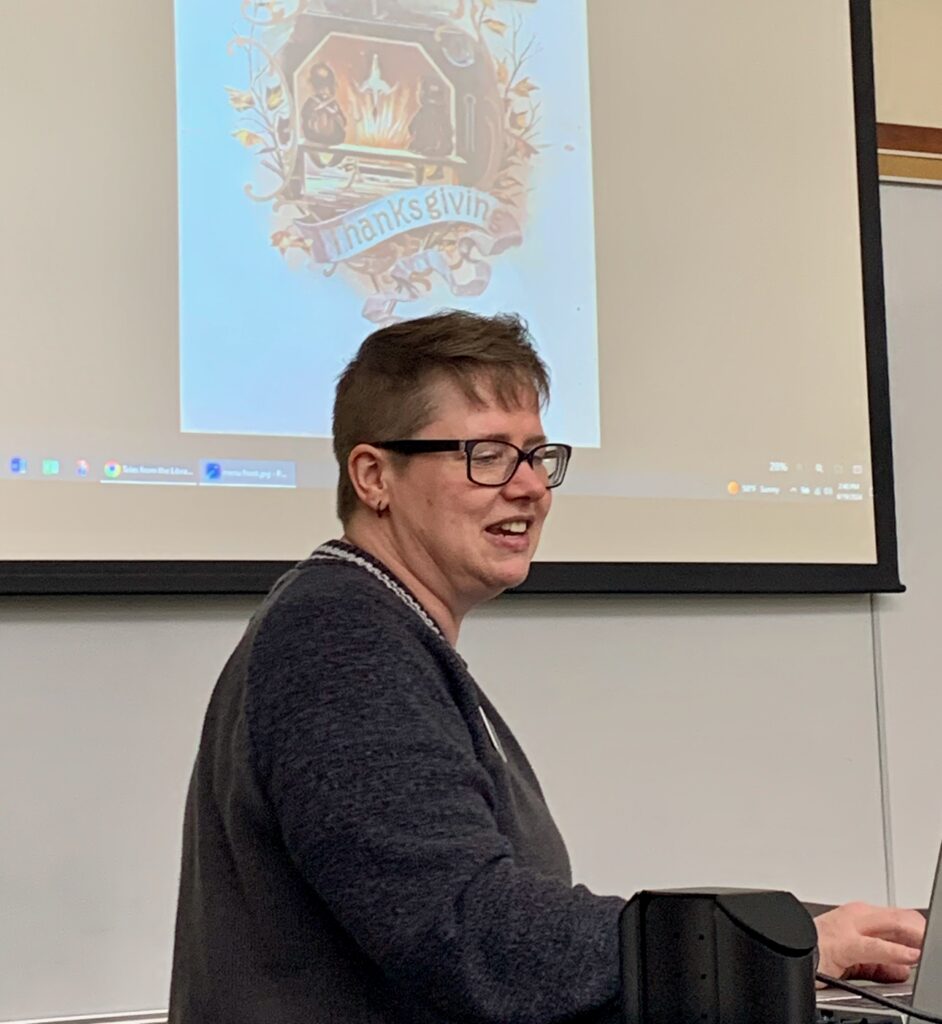
Pratt also surprised the group with a show-and-tell from items patrons don’t get to see every day from the library’s local history collection.
A too-fragile-to-pass-around menu from the Millikin Hotel’s Nov. 28, 1901, Thanksgiving menu, listed a pageful of courses from appetizers through desserts. Food choices included cream of celery, Rockaway oysters, fresh vegetables and fruits, pies, cakes, ice cream, and coffee jelly.
The massive lineup of meat choices—roast sirloin of prime beef aus jus, roast young turkey with cranberry sauce, domestic duck with sage dressing, green goose and apple stew, fricassee of chicken, and potted venison with currant jelly—had people wondering if the holiday diners had to choose a favorite or if they could sample any and all as long as their stomachs allowed.
“I’m not sure what you had to do to get invited to that dinner,” Pratt said.
She also shared a wedding invitation to the ceremony of Helen Canary and Charles Hill, which included the who’s who of Bowling Green guests’ names and the corresponding news article, which interestingly mentions the “original and unique invitations” as well as the list of guests.
“It is wonderful to have the connection between the article and the invitation,” Pratt said. “There are facts in history, but history also evolves because we learn new things all the time. We now have more context of the history” of the wedding and the items shared during the show-and-tell.

